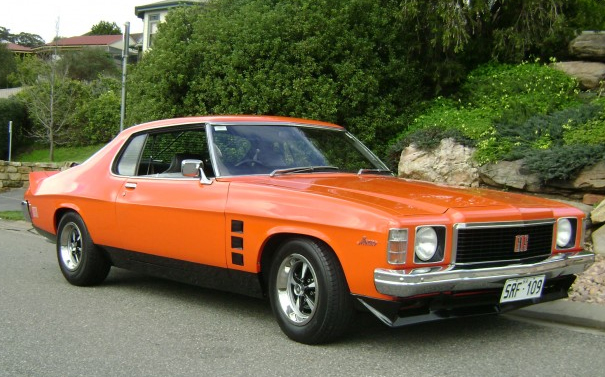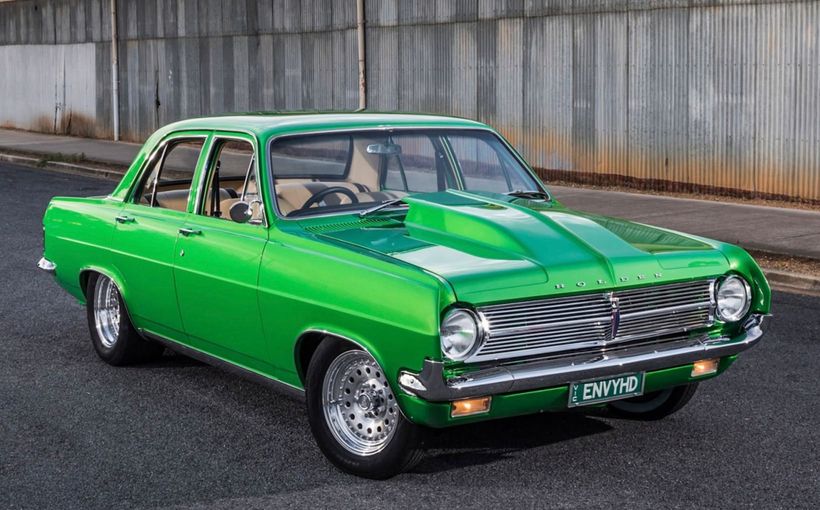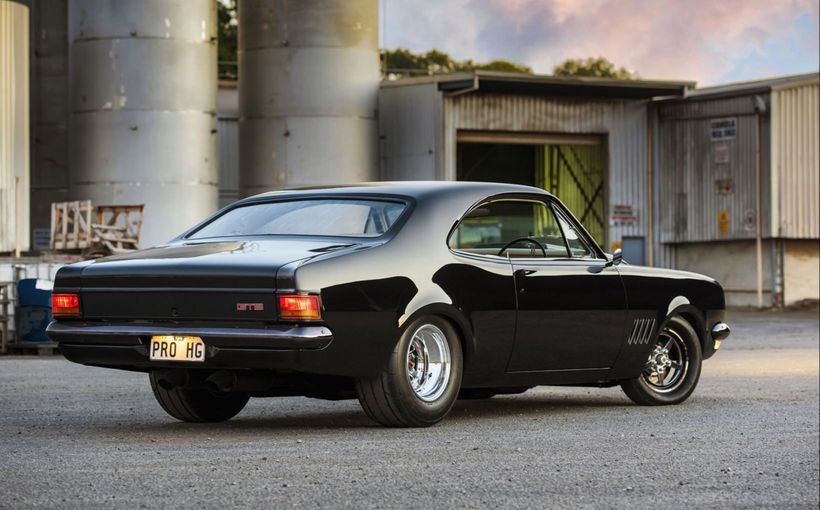Holden HJ/HX Coupes: The Forgotten Monaros

As the HQ Monaro Coupe’s 1971-74 model life equalled the combined HK, HT and HG series without major change, sales stalled. Holden was left with more than1600 surplus HQ Monaro shells. Clearing them over the HJ and HX facelifts proved to be a laborious and time-consuming process.
After HJ coupe sales again dropped, this time to just 606 HJ Monaro GTS Coupes (plus a token 337 HJ LS examples) compared to 4574 HJ GTS 4-Doors, Holden had to pull the Monaro coupe out of production before the end of the HJ series in 1975. This left more than 600 panel sets to clear during the 1976-77 HX series.
At the time, these final Monaros were like dead albatrosses tied around Holden’s corporate neck, a sorry ending for one of the most beautiful styling exercises ever created in Australia. It partly explains why a proposed Monaro revival following the rapturous reception given to Holden’s 1998 Coupe show car generated so much resistance within Holden.
Almost 40 years later, both the HJ and HX can be appreciated for what they are. They remain the final and most refined of all the Monaro Coupes from this era.
Why were the HJ and HX Coupes on the nose?
The answer sheds light on why Holden found itself in deep trouble by the early 1980s. These later Monaro Coupes were amongst the first casualties of several serious errors of judgement and process.
The short story was that Holden had grown so large and unwieldy that it had more internal inertia and politics than an arm of the Commonwealth Public Service.

It is now widely known that sales of the HQ series on release stalled. It was also late. It was supposed to be a late 1970 or early 1971 release. Based on this time frame, a comprehensive facelift in November 1972 was all ready to go.
This 1972 facelift was intended to move the Monaro further from the sedan range with a wild new rear pillar design and tail lights unique to the Monaro. The formal rear side window line of the HQ Monaro Coupe was a last-minute addition which left it with a more conservative roofline than the sedan from some angles.
The HQ shell was then due for complete replacement by around 1974-75 at which point, the full-sized Holden should have ended up looking like the up-to-date stablemate of the LH Torana and TX Gemini it needed to be.
This would also have made the VB Commodore redundant as early as 1975. The success of the XD Falcon which captured the latest European look on a proven full-size platform quickly verified this was the route Holden should have taken in 1975.
Switched-on people within Holden already knew this. Holdens that actually reached the public were now more dependent on internal politics than what the market wanted.
So what happened?
The HQ’s overall shape reflected the best of GM’s US designs for 1969-70 after it had been locked in as late as 1968. The heavily-curved “fuselage” side profile and pointed ends were just as stunning on the HQ as they were on a wide range of US GM muscle cars, including the 1970 Pontiac GTO. Yet this look had already run its course by 1971 in the US, the year it was first seen in Australia.

Meanwhile, GM’s US styling chief Bill Mitchell had correctly anticipated that global design and tastes had quickly shifted towards Europe, even in the US. His many visits to England to see his old mate and former design colleague Davy Jones at Vauxhall, had convinced him that the Rolls Royce Silver Shadow and Jaguar XJ6 along with various Mercedes-Benz models were setting a new design agenda.
It was a trend even more obvious in Australia than the US.
Bill Mitchell then successfully (some would say humbly) translated this across all GM divisions during 1971-74 and forced the entire US industry to follow including Ford. The 1976 Ford P6 LTD in Australia ended up with a front similar to a Jaguar XJ6 or Volvo 164 as a direct result of Bill Mitchell forcing US rivals to pick-up the same European design cues. The Japanese were following as early as 1974.
Because the front styling of the HQ standard wheelbase models was finalized at a much later date than the rest of the car, the HQ hit the Australian market in mid-1971 slightly ahead of the trend. The LJ Torana and HQ Holden fronts were filled in by Leo Pruneau after assignments in Europe with Vauxhall and Opel. Both would have sat comfortably in Opel’s European showrooms in 1972.
The XA Falcon then did more to help HQ sales take off than any other model. Because the XA Falcon had been delayed even longer than the HQ, it arrived in 1972 with a more dated variation of the “fuselage” look. Even if the XA front was inspired by the US Torino, the Torino was not known to Australians. It looked like Ford had capped its first all new Falcon in six years with a grille and front bumper profile that invited a direct comparison with the untrustworthy 1960 XK Falcon. Ford was in trouble.
The XA Falcon (and the VH Valiant) was clearly the work of US designers still believing that recently superseded US designs were right for Australia. The XC Falcon, a hasty rearguard action from local designers, was closer to what the Australian Falcon needed to be in 1972. The 1972 Ford Granada shows how far even Ford of Europe had diverged from the US-designed XA Falcon .
In this company, HQ sales took off at an unprecedented rate as soon as Australians realized that its front styling at least, was the way of the future. The visual link with the dominating LJ Torana GTR XU-1 was also playing its part by 1972.

Before the HQ took off, factions within Holden panicked and scrapped the 1972 facelift which cost the company the perfect follow-up to the HQ.
Re-tooling for the HJ took until 1974 and created three problems: it was late, it killed any chance of a vital new look for 1975 and too much of the HQ still showed which was now a generation out of date.
If you ever go looking for the exact point when the full-size all-Australian Holden was killed, it was here. Adding the 1971 US Chevrolet Monte Carlo front to the HQ to create the HJ was the automotive equivalent of bashing a square peg into a round hole.
So how did that happen? By late 1971, there were factions within Holden who were convinced that the HQ’s problems were caused by its new Opel-style front that had no context on a Holden. It is true that the HG front was intended to lead into an earlier HQ design, not the one that went into production.
They concluded that the solution was to return to the square fronts of Holdens before the HQ. Max Wilson, then Managing Director, was more specific. He insisted on the front of the 1971 Chevrolet Monte Carlo. His judgement could have been on the money but only if it was combined with the squarer and deeper side profiles that Mitchell had also picked-up from Europe.
Because there wasn’t the time to tool up matching side panels, the HJ looked exactly what it was: two disparate generations of GM designs joined together.
Leo Pruneau was never happy with a square and upright HJ front leading into an HQ side-profile that tapered to a point. The VH Valiant suffered from the same problem which was why the local Charger held its appearance longer than the US-style sedans.
Ford designers distracted the eye from the XA’s equally-dated tapered rear for the XC by straightening the sides and increasing the depth of the bumpers. The square rear quarters that the XC needed were reserved for the ZH Fairlane and P6 LTD, a fair spread given that Ford had three model ranges to keep up to date.
The HJ’s bigger tail lights restored some balance from the rear between the HJ front and HQ rear sheet metal but they couldn’t be applied to the leftover HQ Monaro panels. In a desperate attempt to lift the visual height of the HQ rear, Pruneau specified a deep rear spoiler that ran down the sides which blocked the view of the pointy tail from the front.
This was intentional. Yet the almost stepless transition from C-pillar to bootlid was now wrong for the new front and exposed the rear spoiler as the cheap trick that it was.
At a time when the HJ’s looks were needed to compensate for yet another poor-handling Holden and mediocre performance, it was also the most compromised. Australians were not fooled. A round of stunning new European models offered during the HJ’s model life plus the crisp looks of the LH Torana and TX Gemini further exposed the loss of direction.

What was right about the HJ Monaro Coupes
The HJ Monaro Coupes weren’t all bad, even if the market looked the other way.
The lack of visual change was just one of many reasons for the HQ Monaro coupe’s sudden decline. After the HQ’s emissions US 350 engine dropped to 308/5-litre power levels, the GTS 350 could no longer be a Falcon GT rival.
Combined with Holden’s switch to the Torana for race duties, the Monaro’s sporting and performance credentials declined in direct proportion to the extra stripes and warpaint added during the HQ series and beyond.
As long as old school Holden engineer George Roberts refused to budge on the way it drove, the Monaro could never be a sports coupe again. The extra warpaint and the formal front of these later models were even less compatible.
Those older buyers still left in the market also had families and friends who couldn’t or wouldn’t clamber past a front seat to get into the back. Holden was clever enough to generate SS and GTS sedans to address this and both sold up a storm. That only made it harder for the HJ Coupes.
If Max Wilson’s Chevrolet front was right for any Holden, it was the Premier and Statesman models. By definition, that also made it the exact opposite to what was needed to make the HJ Monaro look dynamic and young again. Given that Holden’s only hope was now the older Monaro buyer, the HJ Monaro coupe range hit its target in several areas.
The base Monaro coupe was dropped. The HJ GTS had a much bolder, more formal look than the HQ. Its front spoiler, blacked-out grille and headlight surrounds looked less like other HJ models than the HQ. The three square slots in the front guards also made it look more substantial.
Pontiac’s new polycast (a soft-feel plastic centre moulded into a steel rim) wheel option suited the new look. It was Design Chief Leo Pruneau’s firm belief that the top shelf Monaro GTS should always have featured the quad headlight front. He wouldn’t win that argument in time for the HJ.

The bigger single headlights surrounded by extra paint in combination with the deep, new front bumper gave the HJ GTS a more vertical aspect, perfect for a Monaro buyer who wanted a big Chevrolet personal coupe. As a sporty Camaro alternative, it made the GTS front look like a block of flats at a time when Ford made the XB GT look more aggressive and dynamic.
The outgoing HQ dash design not only looked old hat, it unnecessarily ate into front passenger room. The HJ’s new dash design was its best feature as it gave the cabin a more open and welcoming feel. For the HJ GTS, it was particularly impressive with its finely-detailed round gauges.
Fan boosted face-level vents and the next generation of bucket seats made it one of the best interiors to ride in at the time. Most found the bright stripes in the seat trim too garish but there was no mistaking an HJ Monaro GTS cabin.
The HJ Monaro LS should have been the feel-good HJ coupe to bring home. The wider, more horizontal aspect of the quad-headlight Premier front seemed a better fit with the HQ Coupe styling. The side strips and the black front bumper fill strip made the LS look sleeker than the GTS.
Yet the HJ Monaro LS Coupe was an opportunity wasted. Specifying the base HJ’s dreadful strip speedo and instrument pack in a coupe intended as a feel good package defies explanation. Even if it reflected the parallel Premier sedan, this was a coupe offered at the height of the swing towards Europe and clean analogue round dials were in vogue.
Adding mock wood to this 1968 HK throwback dash only highlighted Holden stupidity and undermined the honesty of the LS package missing from the GTS. The pathetic 337 LS sales highlighted how disconnected from the market Holden had become.
The HX Clearance Special Worth Celebrating
Everything that needed to be said about the HX when it arrived in 1976 was said at the time and doesn’t need repeating here. The bottomline was that it was seen as rubbish at every level as Holden’s lack of direction left the HX Monaro range with poor handling, voracious fuel consumption, questionable reliability and even less performance as a result of some of the worst-prepared emissions engines offered in 1976.
The fact that Holden cleared around 600 Monaro coupe body sets against this backdrop was pure genius. On the rare occasion when those within Holden who knew what they were doing got their way during this period, the market was offered exactly what it wanted.


The HX Limited Edition was never promoted as a Monaro but that’s what it was. It was a sellout success because it consolidated what the Monaro had become without any pretence.
It was a feel-good Coupe that made buyers feel so good, the HX shortcomings faded in the background. It is just a shame that Holden didn’t hold over 300 shells to produce an ultimate HZ version with RTS. Adapting the new RTS suspension under the old shells would have added complication so Holden was on a mission to clear them all by the end of HX.
The HX LE was what the HJ LS should have been. Leo Pruneau finally got his quad headlight grille on the top Monaro model. The HX’s bizarre vertical grille bars were blacked out as were the headlight surrounds. The black front bumper strip plus the front spoiler left the HX LE with a wider, sleeker aspect than any HQ-bodied Monaro before it.
It may have been showing its age by 1976 but there was a timelessness about the LE’s top shelf presentation.
Leo Pruneau drew on the Pontiac Pegasus, a Bill Mitchell Ferrari-powered show car, which featured a special shade of toffee-apple red and elaborate gold striping. A special local version of the Pegasus red was created for the LE and the gold striping with LE decals was tailored to what was a quad-headlight version of the HJ Monaro GTS Coupe body. Even the front spoiler and boot lid had stripes.

As for the Pegasus, the LE’s polycast wheel centres were also gold. The LE centre grille badge was a neat touch.
Inside, the full GTS dash was enhanced with Caprice fittings including extensive wood grain and plush pile carpet. Bright red trim lifted from the Chevrolet Monte Carlo featured brush knit cloth with plaid inserts. Fittingly, the LE was also used to clear Holden’s unsold stock of 8-track cartridge players, about as relevant to the 1976 world of radio-cassette players as the 1971 HQ coupe rear was to a Euro-centric 1976 car market.
Yet, the LE was the first Monaro since the HQ GTS 350 singing from the same song sheet in almost every area, as long as you didn’t look at it from the rear.
Motor Manual was the only local magazine to test it in January 1977, the same issue that was raving about the Sunbird’s RTS. After complaining about the finish and the emissions version of the 5-litre V8, Motor Manual declared: “In concept the LE appears to be the fantasy of a dying coupe granted its last wish before it goes.”
Motor Manual clocked the standing quarter mile (400m) in 17.3 seconds and achieved between 14 and 17 mpg (16-19 litres/100km).
“It has reasonable ride, fair handling, overlight and too sudden power steering. Very much a car of its time.”
If you think about it, this was a back-handed compliment. A 1971 design still selling at a massive $11,000, six years after it was first revealed was more than the original Monaro could manage. The LE restored the dignity that the landmark HQ Monaro coupe design deserved.
Reference: Monaro Magic by Norm Darwin
Protect your Holden. Call Shannons Insurance on 13 46 46 to get a quote today.









